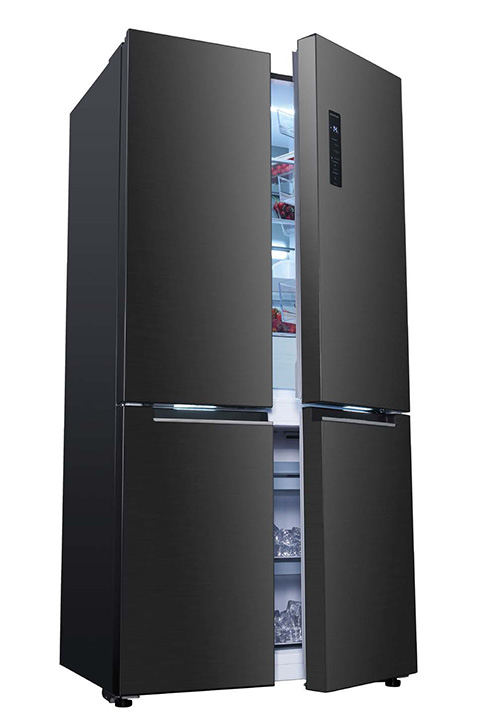
Distinctive design, quality, innovative technologies, smart functionalities, space and energy-consumption optimisation, all define the success of a new way of conceiving home refrigeration that meets the changing needs of global consumers and their evolving lifestyles. Along with the peculiarities of the various countries, there is a common denominator: the search for quality and technology that best serve those new needs.
The multidoor refrigerator is gaining popularity all over the world. Market analysts predict that in the 2022-2030 period, this category of household appliances will grow quite considerably at global level, responding to a demand that has been steadily increasing since 2021.

Globally, the preference for these innovative household refrigeration appliances, boosted by the widespread availability of new preservation technologies, is probably rooted in the great social changes, the new lifestyles and the evolving consumption and nutrition habits taking place in societies across all continents. Consumers nowadays are seeking high-quality, high-tech, efficient design refrigerators with high standards of food preservation and great flexibility in the management of storage spaces, and seem to have found it all in multidoor refrigerators.
Intelligent, low-consumption refrigeration for smart homes and green consumers
The growing trend of designing smart homes and buildings also implies an evolution in the choice of technologically advanced, high- performing and energy-efficient appliances. Refrigerators are no exception: manufacturers are encouraged to make appliances that make the best use of state-of-the-art technologies, such as IoT and smart interfaces for personalised and digital management. Consumers’ and institutions’ growing sensitivity towards the environment and energy saving issues, also pushes the demand for low-consumption, environmentally friendly refrigerators.
.jpg)
(source: The Conscious Consumer - Deloitte)
Growth factors in the refrigerator and multidoor markets

In the Asia-Pacific region, a general rise in disposable income, urban expansion and the increase in the number of individual households significantly influenced the increase of household appliances sales, especially to replace obsolete products. China and India are the largest refrigeration appliance markets in the Asia-Pacific region. North America and Europe, another two titan markets for refrigerators, are characterised by a greater concentration of innovation and technological advancement. In particular, refrigeration solutions have been introduced in Europe to in response to new expectations in terms of quality and customisable technological products. In effect, these products need to meet the changing specifications linked to the new kitchen design trends. The Middle East, Africa, Latin America and Oceania may be minor markets in absolute terms, but are quite significant in terms of overall sales volumes and are indeed interesting for producers since they are almost entirely fuelled by imports. Other growth factors in the domestic refrigeration market are linked to the emerging stay-home and cook trend as a cool way to entertain that has undoubtedly contributed to the increasing demand for refrigerators in general and multidoor in particular.

2.New lifestyles: quality food
The demand for healthy and quality food is booming globally. China is confirmed as the largest importer of Food & Beverage in the world, with import volumes that continue to grow, free from the negative effects of the pandemic. The needs of Chinese consumers are evolving fast, in step with greater economic well-being and evolving lifestyles. They have become more inclined to follow the latest trends and take up new eating habits. Greater internationality and greater focus on sustainability and digitalisation are among the distinctive traits of a new generation of Chinese consumers, who are now on a quest for ever greater quality.
.jpg)
Europe is growing increasingly conscious of the connection between nutrition and health. Together with sustainability and price, health is among the main drivers of purchasing behaviours, with an eye on the authenticity and the origin of products. “Made in Italy” products still retain their appeal in the new lifestyles of the Old Continent. A study of consumers in Belgium, Denmark, Finland, France, Germany, Ireland, Italy, Norway, the Netherlands, Poland, Portugal, Spain, Sweden, Switzerland and the UK, reveals the growing interest of people in the effects of food in terms of well-being and in the impact production and distribution processes have on the environment. Preference for a healthy diet is more marked in Southern Europe countries than markets Northern European. Compared to other countries, Italy is more sensitive to health issues and sustainability rather than price in their food choices. Globally, the search for both quality and affordable prices are leading to more focus and careful selection when it comes to food purchases and storage.
.jpg)
At global level, savings behaviours are emerging as a way to mitigate the pressure of rising retail prices. Grocery buyers are likely to spend more time planning for groceries shopping (41%) and choose to eat at home (45%). Many make new food choices, such as vegetable proteins; in any case, people are not willing to give up eating fresh food in favour of processed food.
The new kitchen

Here the refrigerator - and even more so the multidoor - is indeed displayed as a distinctive element of the furniture and a status symbol: it can only be high-tech, with a minimalist sleek design, premium surfaces and integrated smart functions. The latter are an absolute must in latest- generation technological kitchens, which are increasingly characterised by an innovative and highly functional design.
A hub for food preservation

Fresh vegetables and fruit, meat and fish, are kept in the best possible conditions to ensure top nutritional and organoleptic performance. Some compartments will easily and instantly convert from freezer to refrigerator and vice versa in order to expand, or shrink, the space at will in case some extra storage space is needed for fresh/ frozen food. Most multidoor refrigerators, from French doors to four doors, have premium features, sporting advanced technologies for storing and managing food, smart functions and a distinctive, elegant design that makes this type of refrigerator an appliance that perfectly matches the style and modernity of contemporary kitchens.
Multidoor generation

Two pairs of side by side doors, the top pair for the refrigerator part, and the bottom one for the freezer. In this category several models are equipped with water/ice dispensers, as well as internal viewing systems, and large touch-screen connected displays.

inspired by the design of French wardrobes. The upper part features two doors placed side by side (like the doors of a wardrobe), whilst the lower part consists of two drawers, or three or just one in some models. The side by side doors give access to the entire cavity of the refrigerator, which has no central partition, with the drawers making up the freezer part at the bottom of the appliance.
Copyright © Homa 2024
All rights reserved

.jpg?VGhlIFBlcmZlY3QgU2xvdC1pbijmraPnoa4pLmpwZw==)












.jpg?MTkyMHg3MjDvvIhkZXPvvIkuanBn)
.jpg?MTAyNHg3NDDvvIhkZXPvvIkuanBn)



















